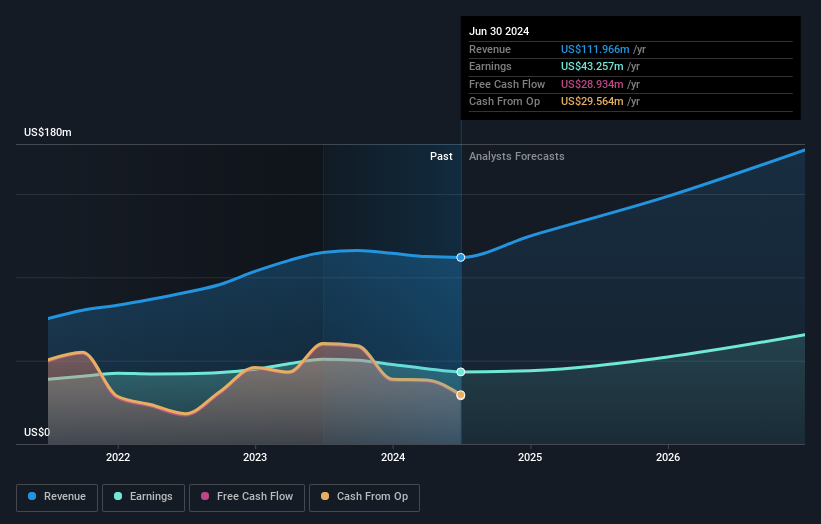Institutional investors are Five Star Bancorp's (NASDAQ:FSBC) biggest bettors and were rewarded after last week's US$51m market cap gain
Key Insights
- Given the large stake in the stock by institutions, Five Star Bancorp's stock price might be vulnerable to their trading decisions
- The top 8 shareholders own 50% of the company
- Recent sales by insiders
If you want to know who really controls Five Star Bancorp (NASDAQ:FSBC), then you'll have to look at the makeup of its share registry. And the group that holds the biggest piece of the pie are institutions with 52% ownership. That is, the group stands to benefit the most if the stock rises (or lose the most if there is a downturn).
And last week, institutional investors ended up benefitting the most after the company hit US$655m in market cap. The one-year return on investment is currently 68% and last week's gain would have been more than welcomed.
Let's take a closer look to see what the different types of shareholders can tell us about Five Star Bancorp.
See our latest analysis for Five Star Bancorp

What Does The Institutional Ownership Tell Us About Five Star Bancorp?
Many institutions measure their performance against an index that approximates the local market. So they usually pay more attention to companies that are included in major indices.
We can see that Five Star Bancorp does have institutional investors; and they hold a good portion of the company's stock. This implies the analysts working for those institutions have looked at the stock and they like it. But just like anyone else, they could be wrong. If multiple institutions change their view on a stock at the same time, you could see the share price drop fast. It's therefore worth looking at Five Star Bancorp's earnings history below. Of course, the future is what really matters.

Institutional investors own over 50% of the company, so together than can probably strongly influence board decisions. Our data indicates that hedge funds own 7.1% of Five Star Bancorp. That catches my attention because hedge funds sometimes try to influence management, or bring about changes that will create near term value for shareholders. Lawrence Allbaugh is currently the company's largest shareholder with 15% of shares outstanding. With 8.8% and 7.1% of the shares outstanding respectively, T. Rowe Price Group, Inc. and Davis Capital Partners, LLC are the second and third largest shareholders. Additionally, the company's CEO James Beckwith directly holds 2.3% of the total shares outstanding.
We also observed that the top 8 shareholders account for more than half of the share register, with a few smaller shareholders to balance the interests of the larger ones to a certain extent.
While studying institutional ownership for a company can add value to your research, it is also a good practice to research analyst recommendations to get a deeper understand of a stock's expected performance. There are plenty of analysts covering the stock, so it might be worth seeing what they are forecasting, too.
Insider Ownership Of Five Star Bancorp
While the precise definition of an insider can be subjective, almost everyone considers board members to be insiders. The company management answer to the board and the latter should represent the interests of shareholders. Notably, sometimes top-level managers are on the board themselves.
Insider ownership is positive when it signals leadership are thinking like the true owners of the company. However, high insider ownership can also give immense power to a small group within the company. This can be negative in some circumstances.
Our most recent data indicates that insiders own a reasonable proportion of Five Star Bancorp. It has a market capitalization of just US$655m, and insiders have US$161m worth of shares in their own names. We would say this shows alignment with shareholders, but it is worth noting that the company is still quite small; some insiders may have founded the business. You can click here to see if those insiders have been buying or selling.
General Public Ownership
The general public, who are usually individual investors, hold a 15% stake in Five Star Bancorp. While this size of ownership may not be enough to sway a policy decision in their favour, they can still make a collective impact on company policies.
Next Steps:
It's always worth thinking about the different groups who own shares in a company. But to understand Five Star Bancorp better, we need to consider many other factors. For instance, we've identified 3 warning signs for Five Star Bancorp that you should be aware of.
If you are like me, you may want to think about whether this company will grow or shrink. Luckily, you can check this free report showing analyst forecasts for its future.
NB: Figures in this article are calculated using data from the last twelve months, which refer to the 12-month period ending on the last date of the month the financial statement is dated. This may not be consistent with full year annual report figures.
Have feedback on this article? Concerned about the content? Get in touch with us directly. Alternatively, email editorial-team (at) simplywallst.com.
This article by Simply Wall St is general in nature. We provide commentary based on historical data and analyst forecasts only using an unbiased methodology and our articles are not intended to be financial advice. It does not constitute a recommendation to buy or sell any stock, and does not take account of your objectives, or your financial situation. We aim to bring you long-term focused analysis driven by fundamental data. Note that our analysis may not factor in the latest price-sensitive company announcements or qualitative material. Simply Wall St has no position in any stocks mentioned.
 Index Options
Index Options CME Group
CME Group Nasdaq
Nasdaq Cboe
Cboe TradingView
TradingView Wall Street Journal
Wall Street Journal